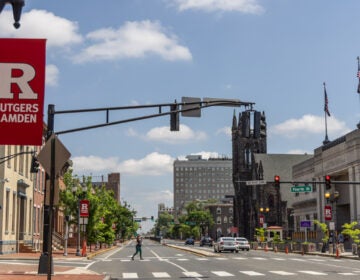Federal Reserve study: ‘Last dollar’ program helps boost low-income college enrollment
The program increased enrollment and reduced student financial stress.

Over 300 graduating students from 19 Philadelphia-area colleges and universities are shown throwing their mortarboards in the air on the steps of the Philadelphia Museum of Art in a 2012 ceremony. (Alex Brandon/AP Photo, file)
Targeted supplemental financial aid can make a difference to low- to moderate-income college students, according to a preliminary report from the Federal Reserve Bank of Philadelphia. The study focused on a Rutgers-Camden program called “Bridging the Gap” that debuted in the fall 2016..
As tuition increases and student loan debt soars nationally, many universities and government programs are looking for ways to reduce financial barriers to college.
The Rutgers-Camden approach, a “last-dollar” program, provides eligible first-year undergraduates with supplemental funding after existing financial aid has been applied. It allows students to cover more — or all — of their tuition.
The key findings “How Does Last-Dollar Financial Aid Affect First-Year Student Outcomes?” showed the program increased enrollment and reduced student financial stress, but it was too early to track how that affected academic performance.
But the program is making a difference, said Keith Wardrip, a co-author of the report that found students who were admitted to Rutgers-Camden, particularly African-Americans and those with lower incomes, were more likely to enroll than similar students from previous years.
“Students from households with incomes below $60,000 were 5 percentage points more likely to enroll at Rutgers-Camden once they were admitted as compared with students from prior years,” she said.
Eileen Divringi, another co-author, said college affordability was a factor.
“One of the clearest findings from our report is that students really respond to messages around college affordability, and their perception of how affordable college is does affect their enrollment decisions,” she said.
Recipients also reported reduced work hours and less reliance on student loans.
The program may also have affected what type of institution students decided to enroll in, she added.
“Students who we spoke to had really been thinking that community college might be the only affordable option,” said Divringi, a community development research associate at the Fed. “A lot of them thought that a four-year degree was sort of out of reach financially.”
These students qualified for substantial financial aid, and college probably would have been less expensive than they anticipated.
“But without the kind of certainty that the program and the messaging around the program provided, they weren’t necessarily viewing college within reach,” she said.
Wadrip, community development research manager at the Fed, said the department does research and outreach around issues that affect low- and moderate-income communities and explores economic inclusion.
“Another one of our focus areas is household financial well-being,” he said. “When you talk about the rise of things like student loan debt and how that’s affecting student and family finances, we thought this was another important kind of program to explore.”
They chose Rutgers-Camden as their case study, he said, because — as a public regional institution — it’s the kind of school most students attend, regardless of their economic background.
One of the surprising findings, Divringi said, is that tuition is not the only financial challenge students face.
“Educational expenses like textbooks or school supplies, even living expenses, such as food and commuting costs, those might seem like a relatively small percentage of the cost of college,” he said. “But for students, those are sort of the immediate day-to-day expenses.”
A takeaway, she said, is the importance of understanding how living expenses and educational expenses beyond tuition affect students’ ability to remain in college.
“Tuition takes up a lot of space in the college affordability discussion, and that’s understandable because it is a large number and has been increasing over time. But a lot of students we talked to — even those who had their tuition entirely covered — did have to take out student loans to cover these other expenses,” Divringi said.
The conversations around student loan challenges and debt burdens need to include other expenses besides tuition.
“It probably shouldn’t be surprising when we are talking about lower income students that discounting their tuition probably is not going to be a silver bullet,” said Wardrip. “If it were, participants in these types of programs would graduate 100 percent. I think that life gets in the way sometimes.”
The authors hope the preliminary information will help other colleges that are considering designing similar programs.
They decided to release their evaluation now because conversations around college access and affordability move quickly and the findings are relevant now.
While it’s too early to track academic performance data, future studies will include academic data, graduation rates and students’ financial strategies and resources.
The Federal Reserve will conduct reports again during year three and year five of the program.
WHYY is your source for fact-based, in-depth journalism and information. As a nonprofit organization, we rely on financial support from readers like you. Please give today.




